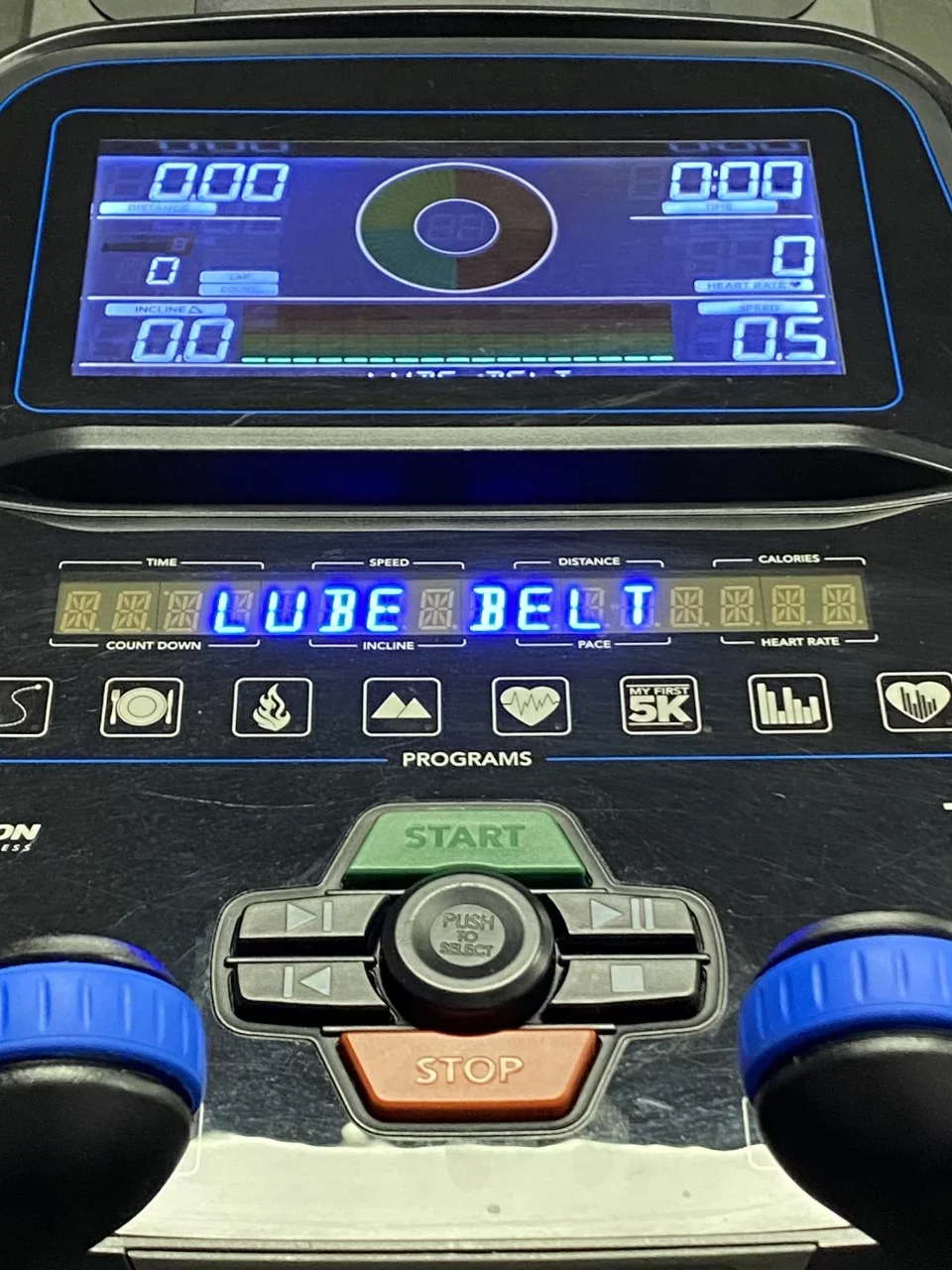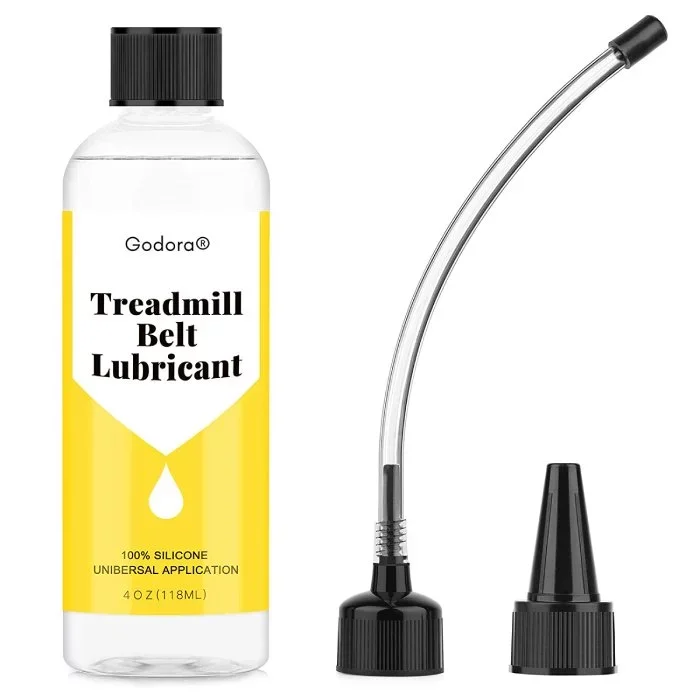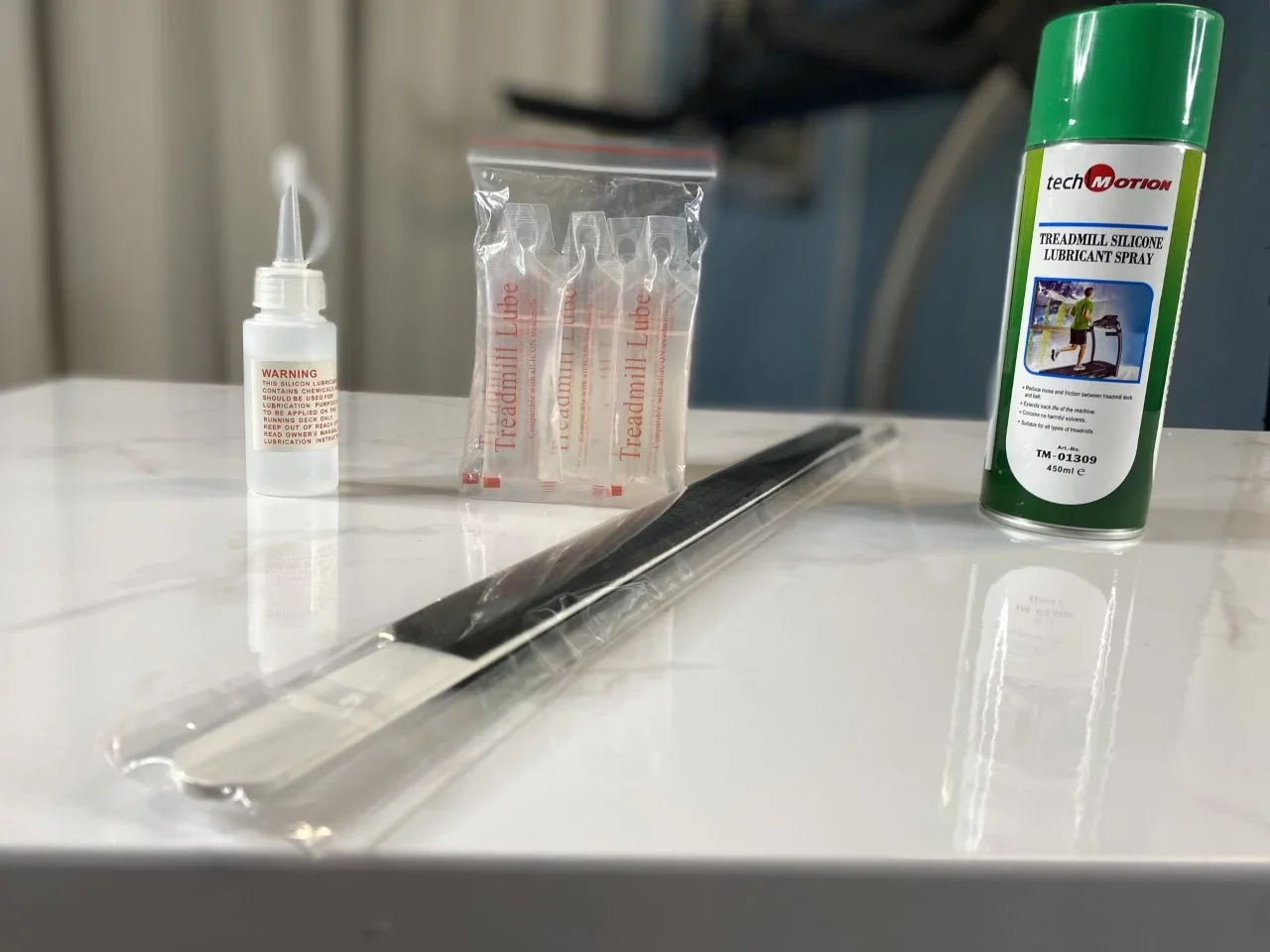The Basics of Treadmill Lubricant
No one buys a car without expecting maintenance duties, yet day people buy treadmills every day without understanding the need for lubrication. Whether you spent $800 or $8,000, the treadmill’s primary parts of concern here are the deck, belt, and motor. To prevent those parts from coming loose or needing replaced, all that’s required is a few simple steps once in a while.
The actual step-by-step process of how to lubricate a treadmill and where to get the proper lubricant, is as simple as replacing the windshield wiper fluid in your car. And while the best home treadmills require little to no maintenance, cheaper treadmills require a little more to keep running smoothly. Even if your tread belt appears to be operating well, be sure to rub in a little lube as needed to prevent future issues. Here are some frequently asked questions we receive about treadmill lubrication.

Some treadmills, such as the Horizon 7.8 AT, display a notice when lubrication is required.
Why Do Treadmills Require Lubricant?
Big or small, the treadmill’s primary parts of concern here are the deck, belt, and motor. The deck is the smooth surface upon which you’ll be walking or running. Most treadmill decks these days are made from Medium Density Fiberboard (MDF), which is also commonly found in kitchen countertops and cabinetry. Smooth, solid, and hard, it provides a great surface on which a tread belt will be pulled by way of rollers connected at either end. This process is all driven by a motor.
Lubricating a treadmill deck at appropriate intervals is necessary to keep all these parts running smoothly. Treadmill belts can be found in single-ply or 2-ply, with 3- or 4-ply occasionally found. A single-ply belt is simply the belt you’ll see on the surface, but a 2-ply belt has an undercoating or cotton, silicone, or some other type of fiber to help it run more smoothly across the MDF, which remember, is made of a material that looks like a kitchen countertop. Cheaper, single-ply treadmill belts are a little rougher a rub on the surface of the deck compared to the 2-ply. But both will need a little lubrication from time to time to allow a smooth run.

Treadmill lubricants help reduce friction between the belt and deck.
If you’ve ever seen a treadmill in action you’ll understand why they’re referred to as “dust magnets.” The whirring motion of that machine’s roller-driven belts will suck up every spec of dust and pet dander around. You’re also likely to bring a bit of dirt with you to the tread every time you step on with your sneakers. Fear not, it’s just life. But where does that dust wind up? Underneath the tread belt and within the motor carriage. Jog after jog, those little specs will begin to provide the stuff of which friction is made, and that’s when your belt begins to wear.
A rougher ride also requires more work for your rollers and thus your motor. The smoother the run, the longer the life of all the working parts. The MDF decks on pricier units are coated with a phenolic resin, which is the same substance used on billiard balls. Cheaper units may costs less than those with MDF as a deck. They might have composite or particle board and won’t be coated as well. You can understand why those would be more prone to belt wear and roller fatigue, particularly if the belt is a cheaper single-ply.
Finally, consider that you’ll be sweating a bit during your run, and even if you’re just walking, air moisture abounds. Your belt will be getting damp then dry between uses, especially if it’s a foldable unit you plan to roll away into a closet between runs. That dust and dryness of storage when combined with the sweat and heat of the use will make the belt brittle over time if left without lubrication.
- Treadmill lubricant reduces friction between the tread belt and motor, significantly extending machine life.
- Treadmill lubricant helps prepare the machine for storage. Without it, the belt can become brittle and break.
- Preventing a tread belt breakdown is always cheaper than buying a replacement.

Treadmill lubricant comes in a variety of containers with different manners of application.
What’s the Worst That Can Happen?
The worst-case-scenario is you’ll need a new treadmill, which is bad. Warranties on these machines run the gamut of a year to lifetime for the deck and the same with the motor. Most machine warranties give at least 90 days for parts and labor, but not all. But if you consider the amount of force you’ll be putting on that machine’s deck, the constant changing of temperature and moisture from hot to cold, plus dirt, you can understand why the deck and motor might simply give up on you without lube.
A quick search online will demonstrate that replacing treadmill belts can add up fast, with examples like a typical ProForm belt running $129.99. Pre-lubricated and 2-ply, it should do the trick given you size it correctly, but that’s a good chunk of change. A replacement 3 horsepower motor from that same manufacturer could run you $300. Replacement rollers trend upwards of $172 and replacement walking decks are about $347. All totaled, that’s $948.99 without shipping, handling, and time spent installing. If you’re still making payments that’s a bit much to swallow.
On the other hand, an 8.4-ounce of silicone treadmill lubricant can be had for $8.99 . It just doesn’t make any sense to ignore regular maintenance.
Will Any Old Lubricant Do?
Negatory. One should never, ever use WD-40 or other sprays meant for metal parts. Remember, the undercoating of a 2-ply deck is made of material which can be dissolved with these chemical sprays.
Most of your better treadmills when purchased will come with a container of silicone lubricant, as well as instructions for application. Each machine is a bit different, but most are similar enough I can assure you it isn’t rocket science. Most treadmill lubricants are made of some kind of silicone-like substance and that’s what you need to use. Baby oil, vegetable oil, or other alternatives are a recipe for disaster.
Precor happens to manufacture a self-lubricating treadmill with a reversible deck, and with that comes a lifetime warranty on the frame and welds, a 10-year guarantee on parts and wear items like the belt, and one year labor. Horizon treadmills meanwhile are now coming with a message system which will flash “Lube Belt” every 300 miles. With the purchase of a new treadmill typically comes a bottle of the manufacturer’s brand of lubricant, and from there it’s easy enough to purchase more online. This is certainly something to consider when shopping for a treadmill.
Be sure to never use a petroleum -based lubricant for your treadmill. Only use those lubes designed for treadmill belts and decks.
How Much and How Often?
Yes, there is such a thing as too much of a good thing. You certainly don’t want to over-lube the machine. A good rule of thumb is to lubricate every three months or 40 hours. You’ll probably want to use an ounce per application, with half an ounce on each side during the process. If you’re a heavier-than-average person, use the treadmill more frequently for longer runs, or have a particularly dusty house, you might want to adjust a bit.
Keep in mind that even if you haven’t used the treadmill in a few months, it’ll still require the lube, just like car parts which haven’t moved in a while. Older models won’t necessarily alert you to the need to lubricate like Horizon, but you might start to feel differences in the belt or tread. Before any damage is done, it’s best to take action.
Lower-cost units with smaller motors, thinner rollers, and single-ply belts might likewise need more care than some of the upper-budget models with more expensive parts. As a general rule, the shorter the warranty offered, the more responsibility for care you’ll be assuming.
Frequently Asked Questions
Can you use WD 40 on a treadmill?
No, WD-40 or other petroleum-based lubricants will ruin your treadmill. Always use the appropriate lubricant specified by the manufacturer or a silicone-based lubricant.
How often should I lubricate my treadmill?
Most treadmills require lubrication every three months or every 40 hours of use.
How much do treadmill lubricants cost?
You can usually find them online for between $8 and $15 per pack depending on size.
Other Treadmill Reviews:
- Test HomePage
- NordicTrack Commercial X14i
- Echelon Stride
- NordicTrack C 590 Pro
- NordicTrack T 7.5 S - Pros & Cons (2024)
- Sole TD80 Treadmill Desk
- NordicTrack Commercial X11i
- NordicTrack T 8.5 S - Pros & Cons (2024)
- Exerpeutic TF1000
- NordicTrack T 6.5 S - Pros & Cons (2024)
- ProForm Sport 5.0
- NordicTrack FreeStride Trainer FS5i (Discontinued)
- Bowflex Max Trainer M5
- BowFlex TreadClimber TC100
- ProForm Power 795
- ProForm Sport 7.0
- NordicTrack Incline Trainer X15i
- NordicTrack C 1650 Treadmill
- Horizon Elite T9
- Official Boston Marathon Treadmill 4.0
- NordicTrack Treadmill Desk
- NordicTrack C 970 PRO

